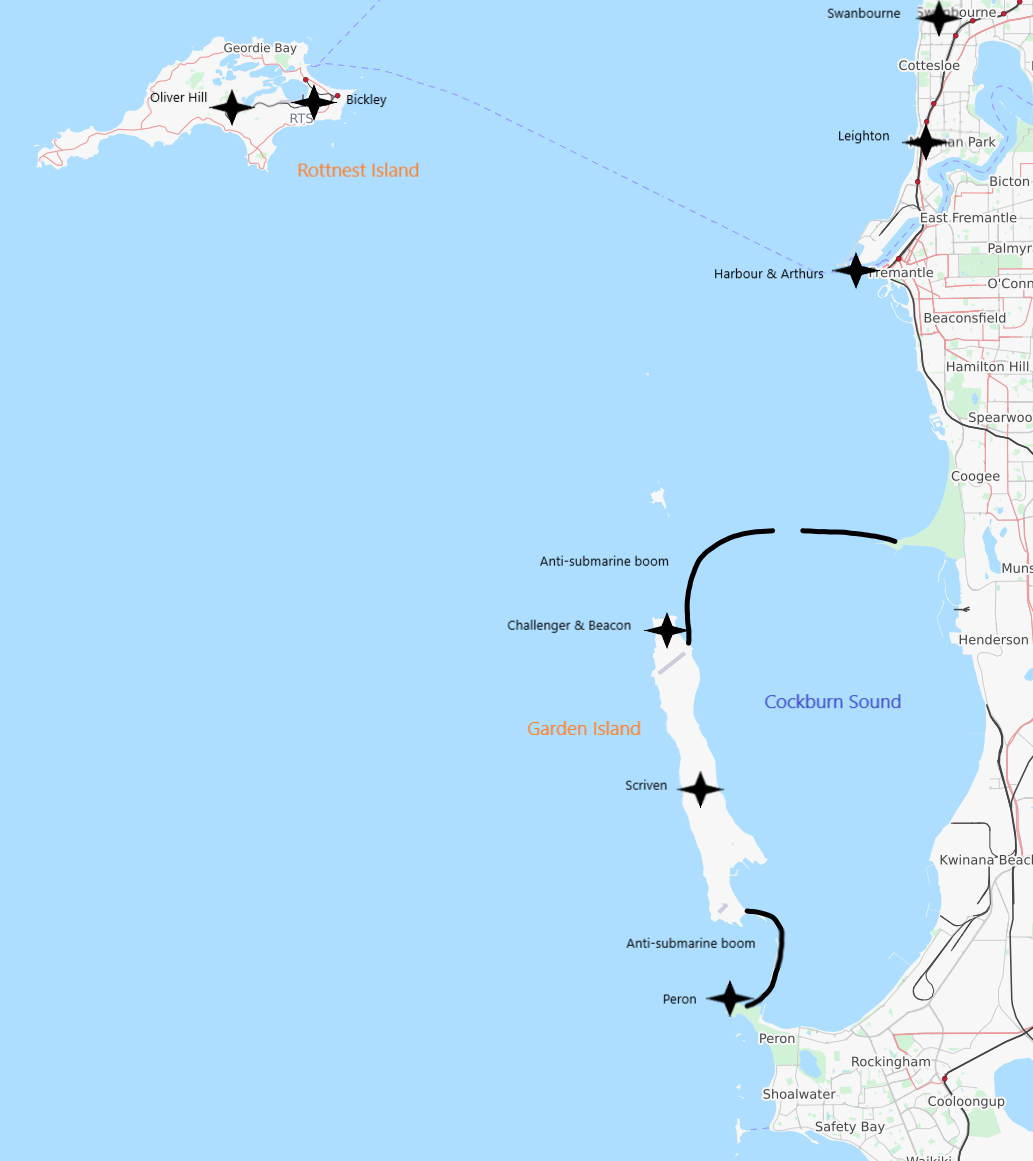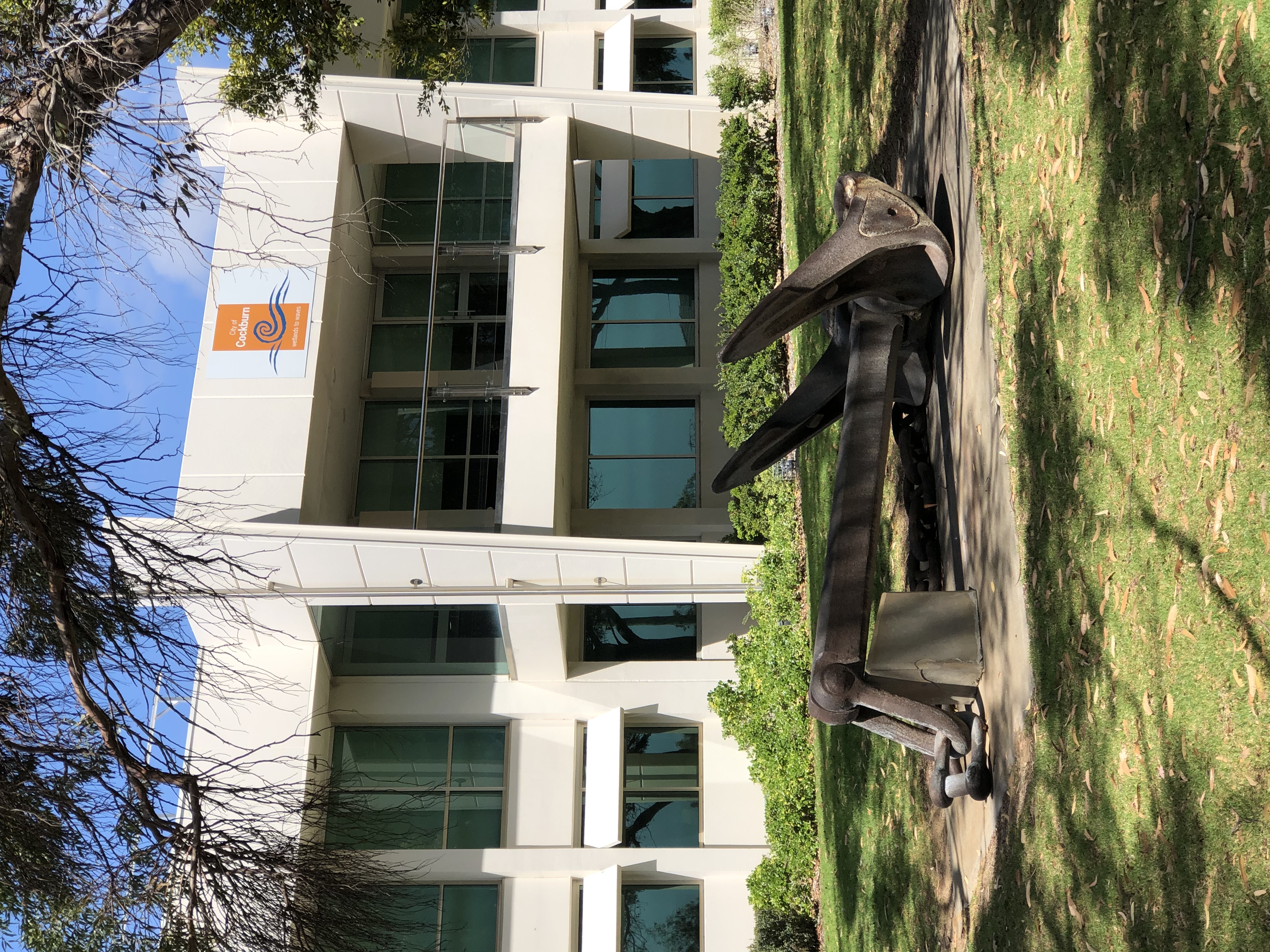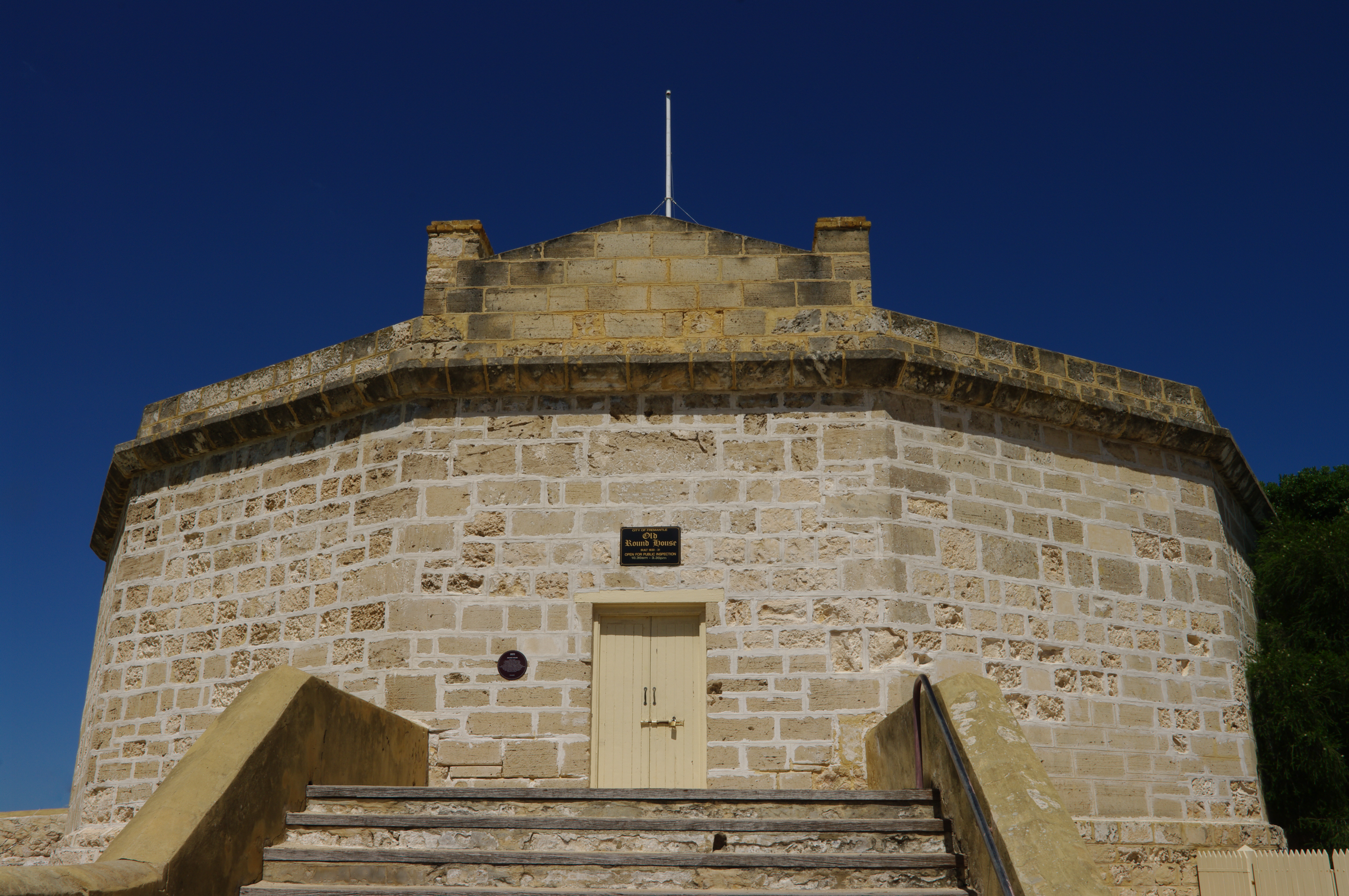|
Fremantle Fortress
Fremantle Fortress was the combined Coastal defences of Australia during World War II, coastal defences protecting Fremantle Harbour, the harbour of Fremantle, Western Australia, since the mid-1930s and, predominantly, during World War II. The coastal defences of the Fremantle Fortress stretched along the coastline of Perth from Cape Peron to Swanbourne, Western Australia, Swanbourne and also included installations on Garden Island (Western Australia), Garden Island and Rottnest Island. While the first coastal batteries of the future Fremantle Fortress were installed at Arthur Head in 1906, the military installations protecting the harbour were expanded in the 1930s, being eventually dismantled again by 1963. During World War II, Fremantle Harbour, guarded by the Fremantle Fortress, was home to the Fremantle submarine base, which was the second-most important submarine base in the Pacific War after Pearl Harbor. The coastal batteries were manned by members of the Royal Australi ... [...More Info...] [...Related Items...] OR: [Wikipedia] [Google] [Baidu] |
Fremantle
Fremantle () () is a port city in Western Australia, located at the mouth of the Swan River in the metropolitan area of Perth, the state capital. Fremantle Harbour serves as the port of Perth. The Western Australian vernacular diminutive for Fremantle is Freo. Prior to British settlement, the indigenous Noongar people inhabited the area for millennia, and knew it by the name of Walyalup ("place of the woylie")."(26/3/2018) Inaugural Woylie Festival starts tomorrow" fremantle.gov.au. Retrieved 5 July 2020. Visited by Dutch explorers in the 1600s, Fremantle was the first area settled by the [...More Info...] [...Related Items...] OR: [Wikipedia] [Google] [Baidu] |
Royal Australian Engineers
The Royal Australian Engineers (RAE) is the military engineering corps of the Australian Army (although the word corps does not appear in their name or on their badge). The RAE is ranked fourth in seniority of the corps of the Australian Army, behind the Staff Cadets, Armoured and Artillery Corps. The corps was formed by the amalgamation of the various colonial engineer corps of the states and territories of Australia in 1902 and since then has served in various conflicts including World War I, World War II and the Vietnam War. The corps has also served on numerous peacekeeping operations and was heavily involved in the Australian contribution to the war in Afghanistan. History The origins of the Royal Australian Engineers date back to 15 November 1860, when the Corps of Engineers was founded in the colony of Victoria by Peter Scratchley. By 1876, five of the six colonies—New South Wales, Victoria, Queensland, Tasmania, and Western Australia—had raised their own enginee ... [...More Info...] [...Related Items...] OR: [Wikipedia] [Google] [Baidu] |
Engineers Australia
Engineers Australia (EA) is an Australian professional body and not-for-profit organisation whose purpose is to advance the science and practice of engineering for the benefit of the community. Engineers Australia is Australia's recognized organization for accreditation of professional engineering qualifications under the Washington Accord. As of 2022, EA has 115,000 members, which includes 31,000 students. History The organisation began after World War I, following recognition of the need for a single body to represent engineers, rather than the numerous smaller organisations that existed then. The first council meeting was held in 1919, electing Professor William Warren of the University of Sydney as the first President.Lloyd, B E (1968) ''The Education of Professional Engineers in Australia'', APEA Melbourne.Lloyd, B E (1988) "In Search of Identity: Engineering in Australia 1788–1988", Thesis for Doctor of Philosophy, University of Melbourne On 1 May 1926 the Institutio ... [...More Info...] [...Related Items...] OR: [Wikipedia] [Google] [Baidu] |
North Mole Lighthouse
The North Mole Lighthouse began operation in 1906 at entrance to Fremantle Harbour. The occulting red light, emitted from a fixed lightsource at a focal plane height of above sea level, is visible for and indicates the westernmost point of the harbour and its entrance. The lighthouse established permanent service from 1906; after the mole's foundations had settled a temporary lighting arrangement there was discharged. The light originally planned for the house was found to be too powerful and was sent to Broome for the steel lighthouse at Gantheume Point. The lighthouse and its technically identical yet green coloured partner on the south mole are the last remaining of their type. It has an 'indicative place' status of the ''Register of the National Estate'' and is a well-known landmark to seamen visiting the port. It was designed by Charles Yelverton O'Connor, an engineer responsible for the construction of Fremantle Harbour and who advanced the proposal of the Goldfield ... [...More Info...] [...Related Items...] OR: [Wikipedia] [Google] [Baidu] |
City Of Cockburn
The City of Cockburn ( ) is a local government area in the southern suburbs of the Western Australian capital city of Perth about south of Fremantle and about south of Perth's central business district. The City covers an area of and had a population of over 104,000 as at the 2016 Census. History Cockburn is named after Cockburn Sound, which was named in 1827 by Captain James Stirling after Admiral Sir George Cockburn. Sir George was born in London in 1772 and was a renowned British naval officer, eventually becoming Admiral of the Fleet and First Sea Lord. He served under Horatio Nelson during the war with France, but came to public attention and was granted his knighthood for his service in the War of 1812, in particular for the burning of Washington in 1814. It was he who took Napoleon to exile on the island of Saint Helena after the Battle of Waterloo in 1815. In 1871, the Fremantle Road District was created under the ''District Roads Act 1871'' to cover the area ... [...More Info...] [...Related Items...] OR: [Wikipedia] [Google] [Baidu] |
Daily News (Perth, Western Australia)
The ''Daily News'', historically a successor of ''The Inquirer'' and ''The Inquirer and Commercial News'', was an afternoon daily English language newspaper published in Perth, Western Australia, from 1882 to 1990, though its origin is traceable from 1840. History One of the early newspapers of the Swan River Colony, Western Australian colony was ''The Inquirer (Perth), The Inquirer'', established by Francis Lochee and William Tanner on 5 August 1840. Lochee became sole proprietor and editor in 1843 until May 1847 when he sold the operation to the paper's former Compositing, compositor Edmund Stirling. In July 1855, ''The Inquirer'' merged with the recently established ''Commercial News and Shipping Gazette'', owned by Robert John Sholl, as ''The Inquirer & Commercial News''. It ran under the joint ownership of Stirling and Sholl. Sholl departed and, from April 1873, the paper was produced by Stirling and his three sons, trading as Stirling & Sons. Edmund Stirling retired five ... [...More Info...] [...Related Items...] OR: [Wikipedia] [Google] [Baidu] |
Henderson Naval Base
Henderson Naval Base was a proposed and partially built naval base of the Royal Australian Navy south of Fremantle, Western Australia in what is now the suburbs of Naval Base and Henderson. Planned in 1911, construction of the base commenced in 1913 but was abandoned during World War I and cancelled in 1920. Temporary naval facilities subsequently existed in the state during World War II but a permanent facility was not established until 1978, when ''HMAS Stirling'' was commissioned. History Studies into the establishment of a naval base in Western Australia date back to 1887, when Sir John Coode, the head of the firm of Coode and Matthews and a respected English civil engineer, visited Australia to select a location for a naval base. He provided a report on his activities four years later, in which he suggested Cockburn Sound as a location. His recommendation was, to drill into Success and Parmelia Banks to establish whether ships could pass through the sandbanks through dredg ... [...More Info...] [...Related Items...] OR: [Wikipedia] [Google] [Baidu] |
Graham McKenzie-Smith
Graham Robert McKenzie-Smith, is an Australian historian and forester. Military historian McKenzie-Smith has written books about Australian Second World War army units and movements. He has been a regular contributor to ''Sabretache'', the journal of the Military Historical Society of Australia. McKenzie Smith spent some 35 years working on ''The Unit Guide'' – a six-volume box set which gives profiles of all 5,700 units that made up the Australian Army in the Second World War. The trove summary for the set states that: ''725,000 Australian men and women joined the Australian Army in World War Two and served in one or more of the 5,700 separate units which were formed in the AIF and AMF... (there were) 5,500 units in the Australian Army during the war (which between them had over 13,700 unit names)...Only 409 (7%) of the units have any published unit history.'' Each unit profile covers what is known of the unit's formation, role, organisation, movements, operations and pl ... [...More Info...] [...Related Items...] OR: [Wikipedia] [Google] [Baidu] |
BL 6-inch Mk VII Naval Gun
The BL 6-inch gun Mark VII (and the related Mk VIII) was a British naval gun dating from 1899, which was mounted on a heavy travelling carriage in 1915 for British Army service to become one of the main heavy field guns in the First World War, and also served as one of the main coast defence guns throughout the British Empire until the 1950s. Background The gun superseded the QF six-inch gun of the 1890s, a period during which the Royal Navy had evaluated QF technology (i.e. loading propellant charges in brass cartridge cases) for all classes of guns up to to increase rates of fire. BL Mk VII returned to loading charges in silk bags after it was determined that with new single-action breech mechanisms a six-inch BL gun could be loaded, a vent tube inserted and fired as quickly as a QF six inch gun. Cordite charges in silk bags stored for a BL gun were also considered to represent a considerable saving in weight and magazine space compared to the bulky brass QF cartri ... [...More Info...] [...Related Items...] OR: [Wikipedia] [Google] [Baidu] |
State Register Of Heritage Places
The State Register of Heritage Places is the heritage register of historic sites in Western Australia deemed significant at the state level by the Heritage Council of Western Australia. History In the 1970s, following its establishment of the National Trust of Western Australia, the National Trust created a set of classified properties, and following legislation requiring inventories, Local Government authorities in Western Australia produced a subsequent set of Municipal Inventories, which then resulted in items then being included in the state register. As a result most register records include dates and details from the three different processes. In some cases authorities other than councils had governance over localities such as ''Redevelopment'' authorities, and they also provided Heritage Inventories in that stage of the process. Registration was not always a successful protection. The Mitchells Building on Wellington Street was State heritage listed in 2004 but demoli ... [...More Info...] [...Related Items...] OR: [Wikipedia] [Google] [Baidu] |
Fremantle Fortress Map
Fremantle () () is a port city in Western Australia, located at the mouth of the Swan River in the metropolitan area of Perth, the state capital. Fremantle Harbour serves as the port of Perth. The Western Australian vernacular diminutive for Fremantle is Freo. Prior to British settlement, the indigenous Noongar people inhabited the area for millennia, and knew it by the name of Walyalup ("place of the woylie")."(26/3/2018) Inaugural Woylie Festival starts tomorrow" fremantle.gov.au. Retrieved 5 July 2020. Visited by Dutch explorers in the 1600s, Fremantle was the first area settled by the [...More Info...] [...Related Items...] OR: [Wikipedia] [Google] [Baidu] |
Panama Mount
Panama ( , ; es, link=no, Panamá ), officially the Republic of Panama ( es, República de Panamá), is a transcontinental country spanning the southern part of North America and the northern part of South America. It is bordered by Costa Rica to the west, Colombia to the southeast, the Caribbean Sea to the north, and the Pacific Ocean to the south. Its capital and largest city is Panama City, whose metropolitan area is home to nearly half the country's million people. Panama was inhabited by indigenous tribes before Spanish colonists arrived in the 16th century. It broke away from Spain in 1821 and joined the Republic of Gran Colombia, a union of Nueva Granada, Ecuador, and Venezuela. After Gran Colombia dissolved in 1831, Panama and Nueva Granada eventually became the Republic of Colombia. With the backing of the United States, Panama seceded from Colombia in 1903, allowing the construction of the Panama Canal to be completed by the United States Army Corps of ... [...More Info...] [...Related Items...] OR: [Wikipedia] [Google] [Baidu] |







